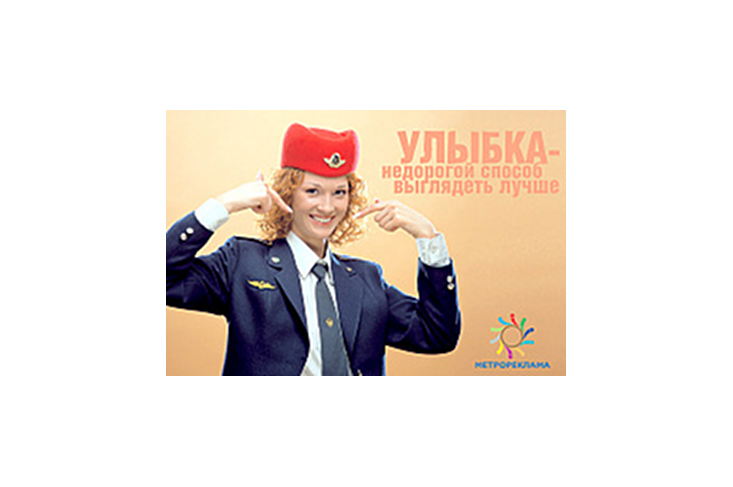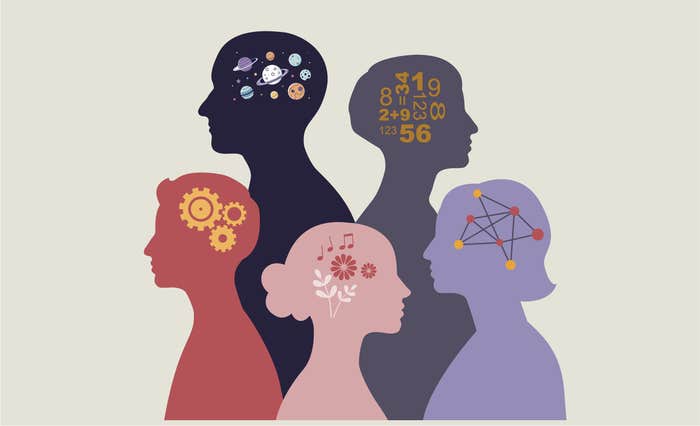When I approach Sofiya Campbell, she regards me and my exuberant smile carefully. It’s only after we shake hands formally that, with a shock of blonde hair lapping at her chin, she returns my smile. I feel some surprise: Russians, as the stereotype goes, don’t smile at strangers.
Sofiya—not her real name—is a 41-year-old Russian woman who’s been living in the United States for the past decade. I found her in a Facebook group for Russian expats living in New York City, and she agreed to meet and talk about American and Russian culture and, in particular, smiling.
We wait in line for drinks for a few minutes, engaging in the same sort of pleasantries she will spend the next hour explaining her dislike for. At one point, she points toward an arrangement of colorful Italian pastries in the bar’s display case. “I don’t know what that is,” she opines in her Russian lilt, unconcerned that the barista might overhear.
After we get our coffees and find seats, she tells me that she finds Americans’ unfailing cheer—the smiles and “how are yous” of neighbors, servers, cashiers, and journalists—tiring. Russian culture, she says, has a different set of standards for polite behavior.

Sofiya is originally from Kazan, a city 500 miles east of Moscow. A promising student who wanted a career, she enrolled in a pre-MBA program in Moscow before becoming one of two students in the program to be awarded a tuition waiver toward an MBA at California State University, East Bay.
Her good luck would wax and wane in the small city of Hayward, California, where CSU, East Bay is located. Sofiya did well. But as she readied herself for graduation, the financial crisis of 2008 socked the country in the gut, and none of the finance jobs she’d hoped for were available. So she started working as a teller at a Wells Fargo branch in San Francisco.
Although she was a proficient English speaker, it was at the bank that Sofiya came face-to-face with her deficiency in speaking “American.” This other English language, made up of not just words but also facial expressions and habits of conversation subtle enough to feel imagined, was one she knew little about.
Russians, as the stereotype goes, don’t smile at strangers.
Even dealing with a simple “How are you?” felt complicated. People in Russia didn’t engage in this kind of social script, and to her it seemed unnecessary. Did they really want to know how she was? No. Anybody who asked only did so in anticipation of a “fine!” or “great!” that would ease them into the next part of the conversation. If she answered honestly (“I’m tired”), which is what felt most natural, she worried she’d come off as rude. And when she preempted the awkwardness by asking “How are you?” first, she felt disingenuous.
The deeper problem was that smiling almost constantly was at the core of her duties as a teller. “The expectation was, you have to smile eight hours a day,” Sofiya tells me. As she smiled at one customer after another, she would wince inwardly at how silly it felt. There was no reason to smile at her clients, she thought, since there was nothing particularly funny or heartwarming about their interactions. And her face hurt.
Sofiya’s experience alone doesn’t prove the stereotype that Russians are relatively cold and brusque. But there is data on the topic. Maria Arapova, a professor of Russian language and cross-cultural studies at Lomonosov Moscow State University, examined how Russians and Americans smile as part of her Ph.D. dissertation, “The Phenomenon of the Smile in Russian, British and American Cultures.” She undertook the project, as she explained to me on the phone from Moscow, in the middle of a divorce. She had been struggling emotionally and wanted to study the cultural concept of suffering, which she saw as being at the core of the Russian soul. But her adviser suggested Arapova might be happier spending several years thinking and writing about smiling instead.
In 2006, Arapova sent a questionnaire to 130 university students from Russia, the U.S., Germany, and the United Kingdom. The first question, whose English-language version contained a charming translation error, read:
You have an eye contact with a stranger in a public place: at the bus stop, near an elevator, in transport. You would:
A) smile and then look away
B) look away
C) gaze at his eyes, then look away.
Ninety percent of Americans, Germans, and U.K. citizens chose option A; 15 percent of Russians did.
The results show that the smile is a reflection, not just of someone’s internal state, but also of cultural history. But if that’s true, where exactly did Russian and American cultures diverge?
Christina Kotchemidova teaches theory, gender, and intercultural communication at Spring Hill College in Alabama. The modern American smile, she theorizes, rose out of a great emotional shift in the 18th century. Prior to this shift, she believes, the American emotional landscape revolved around negative emotions like sadness and melancholy, which were seen as indicative of compassion and nobleness. Informed by ideas from pre- and early Reformation European Christianity, both Americans and Europeans saw earthly suffering as noble and necessary for a happy afterlife. Literature, visual art, and theater in this period aimed to provoke sadness, and crying in public was commonplace in Europe. Diderot and Voltaire, Kotchemidova writes, were seen crying repeatedly.
The Age of Enlightenment pushed the culture in a different direction. As thinkers and artists embraced reason, they also began to believe that happiness was permissible during our earthly life as well as the afterlife. The culture of sadness began to be supplanted by one of cheerfulness, which in turn influenced a changing class structure. The emerging middle class took the ability to manage emotions as key to its identity. Business failures and sickness were linked to failures of emotional control, and cheerfulness to prosperity. Eventually, cheerfulness became a prerequisite for employment.
There is even a Russian proverb on the topic: “Smiling with no reason is a sign of stupidity.”
In 1983, the American sociologist Arlie Hochschild published a book titled The Managed Heart in which she explored what she termed the “commercialization of human feeling” through the lens of one of the most enduring modern symbols of the cheerful American employee: the airline stewardess. Hochschild interviewed dozens of flight attendants and other employees at Delta Airlines, which was then ranked as having the best service among major American airlines (it is still near the top). She found a commodity whose exchange had gone unaccounted for in the usual discourse of commerce. “Emotional labor,” as she called it, was the psychological work the flight attendants were expected to do in the course of their day: appeasing and calming passengers, exchanging courtesies with countless daily customers, and acting cheerfully all the while.
The requirement that the flight attendants appear genuinely upbeat was part of what made this emotional labor so taxing. As Hochschild wrote, “Seeming to ‘love the job’ becomes part of the job; and actually trying to love it, and to enjoy the customers, helps the worker in this effort.” Smiling was so important at Delta that a guest speaker at one flight attendant training session told the assembled students: “Now girls, I want you to go out there and really smile. Your smile is your biggest asset. I want you to go out there and use it. Smile. Really smile. Really lay it on.” Another airline, PSA, used the phrase “Our smiles are not just painted on” as a jingle. Their planes had a stripe of black paint on their noses to suggest a smile.

Hochschild described the commodification of the smile in the service industry as being part of an unprecedented, formalized system for selling cheer that was “socially engineered and thoroughly organized from the top.” She estimated that one-third of American workers, and half of female workers, did jobs that called for substantial emotional labor.
A 2011 study was even able to place a numerical value on the smile: one-third of a British penny. Students at Bangor University in the U.K. were asked to play a simple matching game against computerized avatars represented by photos of people smiling genuinely (with crinkling around the eyes) or just politely (no crinkling). In early gameplay, the students became familiar with the avatars, learning which would be more likely to produce wins associated with small amounts of money. In later gameplay, they were asked to choose the avatars they’d play against.
When students had to choose between a difficult and an easy opponent, they chose the easy opponent when both opponents had the same kind of smile. But they chose the more difficult opponent when its avatar had the more genuine smile. “Participants were willing to sacrifice the chance of a monetary reward to receive a genuine smile,” explained a paper about the study’s findings published in the journal Emotion.
The researchers were able to calculate that their subjects valued a single genuine smile at about a third of a British penny. It’s a small amount, acknowledged one of the study’s co-authors, Erin Heerey, in an interview shortly after the study was published. “But imagine that you exchange 10 to 20 of these smiles in a short interaction. That value would add up quickly and influence your social judgment.”
It’s not that Russians don’t smile, Arapova explains. They do smile, and a lot. “We’re not such gloomy, sad, or aggressive people,” she tells me. But smiling, for Russians—to paint with a broad brush—is an optional component of a commercial or social exchange and not a requirement of politeness. It means something different to smile—in fact, smiling can be dangerous.
In 2015 Kuba Krys, a researcher at the Polish Academy of Sciences, studied the reactions of more than 5,000 people from 44 cultures to a series of photographs of smiling and unsmiling men and women of different races. He and his colleagues found that subjects who were socialized in cultures with low levels of “uncertainty avoidance”—which refers to the level at which someone engages with norms, traditions, and bureaucracy to avoid ambiguity—were more likely to believe that smiling faces looked unintelligent. These subjects considered the future to be uncertain, and smiling—a behavior associated with confidence—to be inadvisable. Russian culture ranks very low on uncertainty avoidance, and Russians rate the intelligence of a smiling face significantly lower than other cultures. There is even a Russian proverb on the topic: “Smiling with no reason is a sign of stupidity.”
Krys’s team also found that people from countries with high levels of government corruption were more likely to rate a smiling face as dishonest. Russians—whose culture ranked 135 out of 180 in a recent worldwide survey of corruption levels—rated smiling faces as honest with less frequency than 35 of the 44 cultures studied. Corruption corrupts smiling, too.
Russian smiles are more inward-facing; American smiles are more outward-facing.
Arapova’s work reinforces the idea that Russians interpret the expressions of their officials and leaders differently from Americans. Americans expect public figures to smile at them as a means of emphasizing social order and calm. Russians, on the other hand, find it appropriate for public officials to maintain a solemn expression in public, as their behavior is expected to mirror the serious nature of their work. This dynamic, Arapova hypothesizes, “reflects the power of the state over an individual, characteristic of Russian mentality.” A toothy “dominance smile” from an important American public figure inspires feelings of confidence and promise in Americans. Russians expect, instead, a stern look from their leaders meant to demonstrate “serious intentions, validity, and reliability.”
Some connect Russians’ unsmiling behavior to traumatic events in the country’s history. Masha Borovikova Armyn, a St. Petersburg transplant who runs a private psychotherapy practice in Manhattan (and also works as a staff psychologist at the Manhattan Psychiatric Center) tells me that in Russian culture, public displays of cheerfulness are often seen as inappropriate for this reason. “There’s just this overall sense of oppression and being oppressed and the majority of people having to struggle a lot to maintain some basic level of livability … It feels perceived to be frivolous to be smiling. Even if you have something to be smiling about in your personal life,” you shouldn’t, she said.
Arapova sums it up this way: Where the American conceives of the smile as a social tool with which to indicate affiliation and connection, Russians take it to be an indicator of “personal affection and good mood.” In other words, Russian smiles are more inward-facing; American smiles are more outward-facing. The commodification of the smile also didn’t take hold in Russia to the same extent that it did in America, perhaps in part because Russian capitalism is a relatively recent phenomenon.

But Russian expats living in the U.S. have been wrestling with capitalism for decades. To see the collision in action, pay a quick visit to Brighton Beach, a Russian enclave at the south end of Brooklyn. If it weren’t for elevated New York City subway cars thundering above the neighborhood’s main strip, you could be forgiven for thinking you were in Moscow. Signs in Russian (and English, Spanish, and Chinese) block out bodega window lights, and fur collars and kerchiefs tied under chins abound. Transactions at the groceries, bakeries, and butcheries begin in Russian, even if they sometimes finished in English. And a kind of gruffness exceeding the usual callousness of New Yorkers hangs on the faces of the neighborhood’s shopkeepers.
On one windy day this February, I watched, stunned, as the owner of a beautiful antique shop castigated a couple for asking for a business card. “Everyone comes in here asking!” the shop owner shouted at the hapless customers. Later, she berated another customer for asking about prices without buying anything. We all looked at the floor and pretended not to be shocked.
The Russian immigrant to America has her work cut out for her. Differences in attitudes toward smiling and pleasantries can extend into the closest relationships. Sofiya has been negotiating culture-linked behavioral differences in her relationship with her American husband for years. She has only a lukewarm connection with her husband’s mother, for example, who tries to be cheerful nearly all the time, and therefore is, to Sofiya at least, infuriatingly indirect. If her mother-in-law were Russian, Sofiya says, at least the nature of their relationship would be clear. “We’d either hate each other or love each other,” she says.
One solution is to seek help from Russian-speaking therapists like Armyn. Reconciling cultural difference is hard, she tells me. She practices a method in which doctor and patient examine the behaviors associated with a particular set of real-life problems sympathetically, with the understanding that they “evolved as a function of needing to survive” under difficult circumstances.
Gulnora Hundley, an Uzbek-born psychotherapist who’s lived in the U.S. for 24 years and offers therapy in English, Russian, and Uzbek, estimates that over a third of her patients are from the former Soviet Union. She also attributes the U.S.-Russia smile gap to traumatic Russian history. “Distrust toward everything makes everybody guarded, and it’s very difficult to get engaged in communication,” Hundley tells me, explaining Russians’ reticence to share personal details. Russians can appear cold and distant to Americans, she says, because they lived in tumultuous environments for years before arriving in the U.S.
Body-language-related communication issues can represent an especially large obstacle to Russian patients whose partners are American. Hundley says she mirrors American body language in her sessions with such couples, occasionally even pointing out when her patients don’t seem to be smiling much. “If they’re sharing their experiences,” she told me, “I try to match their body language … If they’re speaking very softly and quietly, I lower my voice as well … If I notice that there is no smile, even when things are funny, then I may point it out,” she says.
Sofiya is making good progress. After a couple of months of working as a teller, she was promoted to a personal banker position at Wells Fargo. The pressure on her to smile increased as her responsibilities grew, though. Sofiya had to be charming and cheerful enough make at least 10 sales (that is, open 10 bank accounts or credit cards) per day. (In 2016, Wells Fargo was fined $185 million after revelations that its employees had issued credit cards and opened accounts without customers’ consent. Sofiya had left the bank by then.)
Three years ago, Sofiya moved with her husband to Manhattan after he was offered a promotion in New York City. Sofiya, who now works as a senior financial analyst, says she likes New York because it feels more like home than San Francisco did. “People in Russia in general are more like New Yorkers,” she told me. “Californians are very laid back; [New Yorkers] are not laid back … Everybody’s always in a hurry.”
As Sofiya adapts to the U.S., Russia itself may be adapting its own attitudes toward the smile. In a 2013 follow-up to her 2006 study, Arapova found that Russians were smiling more often. Fifty-nine percent of Russian survey respondents said they would smile at every customer who walked into a store they were working in, and 41 percent said they would give a sincere smile to those customers they liked. By comparison, the numbers for the Europeans and Americans were 77 and 23 percent. Arapova says this indicates some leveling of body language differences, which she attributes to globalization.
Still, it’s easy to get ahead of yourself. In 2006, as part of a government-initiated social advertising campaign, ads showing grinning women in suits and red caps standing next to slogans like “a smile is an inexpensive way to look better” appeared in the Moscow subway. Sofiya, who has a vague memory of the ads, says the idea was silly. “I don’t think it worked. No one smiles in the Moscow subway.”
Camille Baker is a French-American journalist based in New York City. She tweets at @camillembaker.
Lead image: kurhan; Badahos / Shutterstock


























